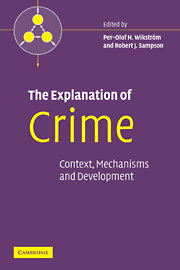Book contents
- Frontmatter
- Contents
- List of figures
- List of tables
- List of contributors
- Acknowledgments
- Introduction: Toward a unified approach to crime and its explanation
- 1 A systemic perspective on crime
- 2 How does community context matter? Social mechanisms and the explanation of crime rates
- 3 Individuals, settings, and acts of crime: situational mechanisms and the explanation of crime
- 4 Evidence from behavioral genetics for environmental contributions to antisocial conduct
- 5 A three-dimensional, cumulative developmental model of serious delinquency
- 6 Self-control and social control of deviant behavior in context: development and interactions along the life course
- 7 Desistance, social bonds, and human agency: a theoretical exploration
- Index
- References
3 - Individuals, settings, and acts of crime: situational mechanisms and the explanation of crime
Published online by Cambridge University Press: 22 September 2009
- Frontmatter
- Contents
- List of figures
- List of tables
- List of contributors
- Acknowledgments
- Introduction: Toward a unified approach to crime and its explanation
- 1 A systemic perspective on crime
- 2 How does community context matter? Social mechanisms and the explanation of crime rates
- 3 Individuals, settings, and acts of crime: situational mechanisms and the explanation of crime
- 4 Evidence from behavioral genetics for environmental contributions to antisocial conduct
- 5 A three-dimensional, cumulative developmental model of serious delinquency
- 6 Self-control and social control of deviant behavior in context: development and interactions along the life course
- 7 Desistance, social bonds, and human agency: a theoretical exploration
- Index
- References
Summary
The questions, “Why do people commit crime?” and “What can we do about it?” are central to any society. The answers to these questions require a basic understanding of what causes crime. I submit that criminological theory, by and large, has not been able to fully address the problems of causation and explanation. I argue that a major reason for this is that criminological theory generally suffers from a lack of a theory of action, a poor integration of levels of explanation and an unclear definition of crime (Wikström, 2004).
Without a clear conception of
what crime is (what the theory should explain),
what moves people to commit acts of crime (a theory of action), and
how individual characteristics and experiences and environmental features interact in this process (integration of levels of explanation),
we cannot fully address the causes of crime. Moreover, without addressing these points in depth we lack the necessary theoretical foundation to evaluate fully the role of individual development and change (Wikström, 2005) and the role of systemic factors and their changes over time (Wikström & Sampson, 2003) in the explanation of crime.
Crimes are acts of moral rule-breaking. To explain crime is to explain why individuals break moral rules defined as crime in law. Crimes are acts committed by individuals. To explain acts of crime is to explain what moves individuals to break moral rules defined in law.
- Type
- Chapter
- Information
- The Explanation of CrimeContext, Mechanisms and Development, pp. 61 - 107Publisher: Cambridge University PressPrint publication year: 2006
References
- 199
- Cited by

